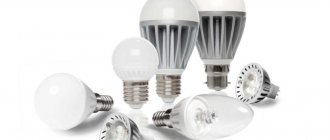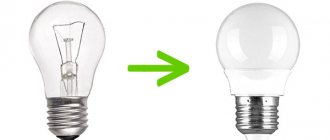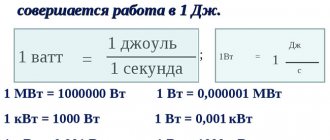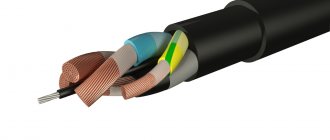The principle of operation of incandescent lamps under load.
The filament of an incandescent lamp experiences the greatest load at the moment it is turned on. This is due to the fact that the light bulb coil in a cold state has a resistance tens of times less than when it is hot.
Experimental testing of the most common incandescent electric lamps with a power of 25, 40, 60, 75, 100 W shows that their cold resistance is 155.5; 103.5; 61.5; 51.5; 40 Ohm, and in the working one - 1936; 1210; 815; 650; 490 Ohms, respectively. Then the ratio of “hot” to “cold” resistance is 12.45; 11.7; 13.25; 12.62; 12.4, and on average it is 12.5. These indicators are taken from the reference book. But out of curiosity, our electricians in Korolev carried out such experimental measurements and came up with the same numbers.
As a result, the incandescent lamp, when turned on, operates under extreme conditions at currents that exceed the rated one. This leads to a reduction in the life of incandescent light bulbs, accelerated wear of the filament and premature failure, especially when the voltage in the supply network is exceeded. The latter circumstance, with prolonged excess voltage relative to the nominal one, leads to a sharp reduction in the service life of the lamp. As a result, the next time you press the switch, the light bulb will burn out, and the machine in the panel may even turn off. Are you wondering what to do if the lights go out and the apartment loses power?
Miniature and subminiature lamps
Improvements in the production technology of thin tungsten wires (less than 10 microns) have made it possible to create a wide range of miniature and subminiature lamps. The latter have found wide application in medical devices, as indicators in electronic equipment, in computer technology and aircraft. All lamps are designed for low voltage, allowing the use of a short filament length, and are manufactured for low power. In the requirements for lamps, current is often indicated instead of the rated power. Requirements for miniature incandescent lamps are combined in GOST 2207-74. Although lamps have different applications, combining them into one standard is justified by the fact that their manufacture requires the use of special technological equipment. The smallest threaded and pin sockets are used for lamps. A typical design of miniature lamps is shown in Figure 7, subminiature - in Figure 8.
| Figure 7. Miniature incandescent lamps | Figure 8. Subminiature lamp |
The service life of an incandescent lamp is highly dependent on operating conditions.
The service life of a conventional incandescent light bulb depends on:
- on the quality of wire switching;
- on the quality of installation and connection of the chandelier;
- on the build quality of the lamp;
- on the stability of the rated voltage;
- from the presence or absence of mechanical impacts on the lamp, shocks, shocks, vibrations;
- on ambient temperature and humidity;
- on the type of switch used and the rate of increase in current when power is applied.
How to choose the right product for your home
The range of incandescent lamps on the market is so diverse that you can get lost and make the wrong decision. Which company's products are better is up to everyone to determine for themselves. Everyone's selection criteria are different. For some, it is enough to purchase simple, inexpensive models, while others need the ability to connect a dimmer, regardless of how much the device costs. When purchasing products, experts recommend paying attention to the following parameters:
- Colorful temperature. Incandescent lamps have a standard value of 2700 K. The color is warm. Suitable for bedroom and living room. Allows you to bring an atmosphere of warmth and comfort. It is worth noting that color temperature does not have any effect on the amount of light or its quality. The choice depends on personal preference.
- Power consumption indicator. The value in LN is from 40 to 60 W. However, the energy consumption value is not the main indicator of luminous flux, which affects the brightness of the product.
- Color rendering index. Defined in Ra. Affects the correct perception of the shades of objects when light from a lamp hits them. Experts advise taking this characteristic seriously, since a mistake in choosing can negatively affect the uniqueness and beauty of the existing interior. The manufacturer indicates the color rendering index value on the packaging.
- Stability of the luminous flux. The coefficient indicates the operating time of the device, during which the brightness of the luminous flux is set to 30% less than the nominal value.
How to increase the life of an incandescent lamp.
In order to extend the resource and operational life, it is necessary to understand why incandescent electric lamps burn out. When a light bulb operates for a long time, its filament gradually evaporates under the influence of high heating temperatures, decreases in diameter and breaks (burns out).
The higher the heating temperature of the filament, the more light it emits. In this case, the filament evaporation process becomes more intense and the lamp service life is reduced. Therefore, for incandescent lamps, the filament temperature is set at a temperature that ensures the required light output of the lamp and a certain duration of its service.
You can increase the service life of incandescent lamps by including soft starters in the circuit, which will smooth out the load that occurs at the start of a cold lamp. To clarify possible ways to extend the operation of lamps, consult a specialist. For example, our electrician in Mytishchi, at the entrance of an apartment building, assembled a staircase lighting circuit, calculating the optimal operating life of the lamps. Our masters who provide electrician services in Pushkino have the same experience.
How to deal with electric shock
Now let's deal with the main problem, which we left for last - electric shock during switching on. As I already said, ordinary incandescent lamps are not protected from it in any way. Lamp designers reached an acceptable service life of the light source, and left everything that way. Meanwhile, the switching current can be successfully combated. How to extend the life of incandescent lamps, which, due to their design features, are not ready for long-term use? Let's consider the main methods of dealing with heavy starting, which reduces the service life of light bulbs. Among them:
- Reduced supply voltage.
- Smooth heating of the coil.
Each of the options for increasing the service life of an incandescent device has its own advantages and disadvantages, but both have the right to life.
- We increase the service life by lowering the voltage Surely you know that alternating current changes its polarity: first it flows in one direction, then in the other. First, in the socket on the phase wire relative to the zero one there is positive, and then negative, and so on 50 times per second. Now let's look at a diode - a semiconductor device you know from school. Its main property is the conductivity of current in only one direction. What happens if you connect a diode in series with a light bulb? Absolutely right - on a lamp connected through a diode, there will be approximately half of the effective voltage; alternating current will not be able to flow in the other direction. This means that at the moment of switching on, the current through the lamp spiral will be lower, which will significantly extend the service life of the lighting device. And here is a schematic solution to the problem:
Extending the life of a light bulb using a diode
If the lamp power does not exceed 100 W, then almost any diode designed for a reverse voltage of at least 400 V and a forward current of at least 0.8 A can be used as D1. If the lamp is more powerful or weaker, then forward current diode needs to be proportionally increased or decreased.
You can embed the diode itself into the wiring almost anywhere: in a lighting fixture, in a switch. Or you can simply connect the diode to the break in the wire powering the lamp. In this case, there is no need to look for the “plus” and “minus” of the semiconductor; the polarity of the diode does not matter and will not affect the service life of the light bulb in any way.
A simple and seemingly ideal way to extend service life, but it has a significant drawback. Since the diode cuts off one half-wave of the mains voltage, its frequency (voltage) is halved. This leads not only to an increase in the life of the lamp itself, but also to a very noticeable flickering of the light. This reduction in lighting quality is unpleasant to the eyes and harmful over long periods of use. Therefore, the option of increasing the service life of a light bulb using a diode is suitable only for emergency light sources, in particular, for illuminating utility rooms and staircases, where people stay for a short time.
Let's try to eliminate the flickering of the lamp, while maintaining the service life unchanged. To do this, we will use the properties of alternating current. Let's turn on a capacitor instead of a diode.
Extending the life of a light bulb using a ballast capacitor
Since the capacitor resists alternating current, some voltage will drop across it. As a result, the light bulb, as in the case of a diode, will shine with underheating. But since the capacitance does not simply cut off one half-wave of alternating voltage, but limits the current in both directions, the lamp will not flicker. Its service life will be the same as when the diode is turned on. If you decide to assemble this circuit, then you will have to take a paper capacitor with an operating voltage of at least 400 V and a capacity of 2 to 10 μF. Moreover, the higher the capacity, the brighter the lamp will shine and the shorter its service life.
There is another method that allows you to reduce the supply voltage without increasing ripple and significantly increase the service life of the lighting device. To do this, just turn on 2 light bulbs of the same power in series.
Increasing the service life of lamps by switching them in series
In this case, the voltage between the bulbs will be divided in half, and each will receive 110 V. Of course, you will have to splurge on buying a second lamp, but they are inexpensive, and the increased service life of such a light will more than cover all costs.
These two methods of increasing service time are the simplest, but, alas, not the best. In both cases, the lamp operates at a reduced voltage. This, of course, increases its service life, but significantly affects not only the quality of lighting, but also the energy efficiency of the light source. As I said, the optimal filament temperature of the tungsten filament, at which the lamp efficiency is maximum, is 2,000 degrees Celsius. But with the voltage reduced by almost half, the light output of the lighting device will drop by 4 times!
- We provide a “soft” start
Since the heaviest mode for a lamp, which significantly reduces its service life, is the moment it is turned on, it is not necessary to constantly power it with a reduced voltage. It is enough just to increase the duration of the filament of the spiral. Under normal conditions, the lamp heats up in milliseconds. But if you increase this time to a second, temporarily limiting the current through the spiral, then the problem of increasing the trouble-free service life of the lighting device will be solved.
One of the simplest and most inexpensive options for increasing operating time is to connect a thermistor in series with the light bulb. A special feature of this device is the strong dependence of the electrical resistance on the body temperature. There are two types of thermistors: with positive and negative TCR (Temperature Coefficient of Resistance). As the temperature increases, the resistance of the first type increases, and the resistance of the second decreases. I think you already get the idea.
If you place a device with a negative TCR in series with the lamp, then at the moment of switching on its resistance is high, and the current through the lamp is greatly limited. As the spiral heats up, the thermistor itself heats up by the flowing current. Its resistance drops and after a while becomes minimal. This stops the work of limiting the current through the lamp, which by this time has already warmed up. The scheme for the practical application of this method is extremely simple and almost everyone can assemble it:
Extending lamp life using a thermistor
Finding such a thermistor is not difficult; it was widely used in almost all domestic televisions of 2-5 generations for the demagnetization system, and it is quite inexpensive. The effect of such a modification is obvious: a significant increase in the service life of the lighting device without deteriorating its other characteristics (efficiency and luminous efficiency).
The scheme for increasing lamp life is ideal, but what's the catch? The fact is that during operation the thermistor heats up to 60-70 degrees Celsius. You can no longer insert it into a switch or a plastic chandelier base. The only possible installation location is in the area of the lamp base, which is not always convenient or aesthetically pleasing. And, of course, electricity is constantly spent on heating.
On a heated thermistor, with a lamp power of 75 W, about 2.5 V drops. It is easy to calculate that the power consumed by the resistor will be about a watt. The overexpenditure is not that big, so the scheme can be considered quite economical.
There are also more complex soft start circuits that increase the service life of light bulbs. But their repetition requires some knowledge of electronics, so I will not consider them here. In such designs, semiconductor devices are used as a regulating element: thyristors or transistors.
If you don’t want to pick up a soldering iron at all, then you can use a ready-made solution. For example, a dimmer with a rotary knob or a special protection unit (those used for halogen lamps are also suitable for ordinary lamps), which can be found in any specialized store. They are not cheap, but over time they will pay for themselves, since the service life of the light bulbs will increase significantly. Any electrician can install the purchased device. You can do this yourself if you know what a screwdriver is for and what a voltage indicator (indicator) is.
A soft-start dimmer (left) and a “soft” start block for incandescent lamps will significantly extend the life of lighting fixtures with incandescent bulbs
Now you know why incandescent lamps burn out, and if you wish, you can significantly extend their service life yourself at minimal cost.
The average lifespan of an incandescent lamp is 1000 hours.
The average burning time of an incandescent lamp at the design voltage does not exceed 1000 hours. After 750 hours of burning, the luminous flux decreases by an average of 15%.
Incandescent lamps are very sensitive to even relatively small increases in voltage: with a voltage increase of just 6%, the service life is halved. For this reason, incandescent lamps that illuminate staircases burn out quite often, since at night the electrical network is lightly loaded and the voltage is increased.
Principle of operation
The source works by emitting wave radiation due to electronic molecular excitation and atoms, as well as due to thermal vibration of the filament molecular nucleus. As the temperature of the filament increases, the translational, vibrational and rotational energy of charged particles increases. As a result, the flux of radiation with average photon energy increases. The radiative wavelength moves into the short-wave infrared and long-wave visible regions. In the future, the body temperature will increase, providing energy that is sufficient to excite molecules and atoms and produce short-wave visible radiation. Therefore, the main factor that determines density with radiation wavelength is temperature.
You may be interested in this Features of the DRL lamp
Operating principle of incandescent lamps
Operational service life of energy-saving LED lamps.
LED lamps do not have an incandescent filament and are designed completely differently than ordinary Ilyich light bulbs. In connection with a fundamentally new manufacturing technology, it can be noted that their main advantage is the longest service life. Manufacturers claim a nominal life of up to 50,000 hours! Compared to incandescent light bulbs, this is 50 times more. If we recalculate these indicators based on the mode of use in normal home conditions, then we can say that an LED light bulb will last 15 years. And this, you see, is a significant period. During this time, you can forget the simplest procedure for replacing a light bulb in home lamps.
Unfortunately, in practice, the service life of LED lamps varies depending on the manufacturer around the figure of 5 years, which, of course, still exceeds the service life of conventional incandescent light bulbs.
Marking
All types of lamps have their own letter designation, but this should not be confused with the type of base, for example, E27.
The marking of light bulbs with filament contains:
- The first letters (from 1 to 4) indicate important physical properties or design features: V-vacuum, G - gas-filled monospiral with argon filling, B - gas-filled double-spiral, K - filled with krypton, MT - flask with a matte coating, etc. Special incandescent lamps do not have these letters in their markings.
- The second part of the designation consists of 1 - 2 letters and indicates the purpose of the device: A - automobile lamp, Zh - railway lamp, KM - switchboard, PZH - floodlight, etc.
- The first digital part indicates the rated voltage and power, and the second indicates the development number, if it is repeated. For example, B235 - 245 - 60 means that the lamp is bispiral, powered by a voltage of 245 V, rated at 60 W.
If a person knows how to decipher the markings, then he will be able to choose a suitable incandescent light bulb.
The guaranteed service life of energy-saving fluorescent lamps is up to 20,000 hours.
In terms of production technology, fluorescent lamps also differ significantly from incandescent lamps. Inside the lamps there is an inert gas and mercury vapor. An electric current passes through the lamp, resulting in ultraviolet (UV) radiation. The internal surfaces of the lamp are coated with a special substance - phosphor. It absorbs ultraviolet radiation and converts it into visible light. The so-called luminescence phenomenon occurs.
The service life of fluorescent fluorescent lamps ranges from 2,000 to 20,000 hours. Manufacturers stipulate ideal operating conditions, under which it will be possible to use fluorescent lamps for as long as possible. First of all, there should be no more than 5 on/off switches. Therefore, these fluorescent lamps are not suitable for use in areas where switches are frequently flicked, or in conjunction with motion sensors. In addition, there should be no voltage surges.
Unfortunately, the actual service life of fluorescent lamps does not always live up to the declared ones due to the fact that there are a lot of low-quality light bulbs on sale, mainly made in China.
Design, classification and advantages
Despite the variety of light sources with filament body, the main design elements are:
- flask made of honeycomb or frosted glass of different sizes and shapes. It protects the filament body from environmental influences;
- the filament body, as a rule, is a wire of a certain diameter or metal strips;
- plinth of standardized sizes. Lamps for household use have the symbol E14, E27 and E40 (threaded), where the number indicates the size of the outer diameter in mm. For halogen products, the base is designated by the following abbreviation - G4, GU9, GU10, GU5.3, GU6.35, R7S, E14 and E27.
Lamp bulbs are evacuated and filled with inert gases, halogens or their compounds.
Some types of incandescent lamps are made without a base. Such products are especially widely used in the automotive industry.
All products are classified according to the following criteria:
- functional purposes (local, general purpose, decorative, transport, mirror, spotlight, signal, illumination, optical). In addition, manufacturers produce a wide range of light sources for special purposes. These include projection lamps, double-filament lamps, incandescent lamps, heating lamps, low-response lamps, switch lamps and special-spectrum lamps. A special niche is occupied by vintage incandescent lamps - products imitated as antique.
- type of filling of the flask (vacuum, nitrogen-argon, xenon-halogen, krypton, with a special coating for converting infrared radiation into the visible spectrum);
- flask shape (drop-shaped, candle-shaped, mushroom-shaped, cylindrical, linear, etc.);
- designs of filament bodies (round diameter and strip);
- type of base (threaded, pin, single- and two-pin);
- color of execution (transparent, matte, blue, red, yellow, green, purple);
- scattering angle (10, 38 and 60 degrees);
- overall dimensions (standard version, miniature, subminiature);
- power (from 15 to 20000 W);
- voltage (12, 36, 127 and 220 V).
The design of some models may contain a reflector (reflector) to direct the light flux.
The main advantage of incandescent lamps compared to other types of light sources is their price. It is the lowest, which made them the most used and in demand. The advantages include no blinking during operation, low sensitivity to power surges and power failures, an eye-pleasing emission spectrum, a high color rendering index, and instant switching on. The main disadvantages include 2 factors - short service life (1000 hours) and low efficiency (5 - 7%).
Service life of halogen lamps.
Halogen lamps are similar in structure to incandescent lamps. They also have a spiral. But their flask is filled with a special, so-called buffer gas: halogen vapor (bromine or iodine). Halogen vapors increase the life of the light bulb to 2,000 - 4,000 hours. Moreover, the smaller the halogen bulb, the longer it will last.
When using soft starters, the operating life of halogen light bulbs can be increased to 8,000 - 12,000 hours. If we compare halogen lamps with LED lamps, the former, of course, are significantly inferior to the latter. But at the same time, they can be freely used in conjunction with a dimmer or diode switch, just like incandescent light bulbs.
If the material in this article was interesting and useful for you, share it with your friends on social networks. Perhaps this information will be very useful to someone. Sincerely, Royal Electrician in Shchelkovo.
Types of lamps and their functional purpose
There are many incandescent lamps, they are classified according to their functional purpose and design features.
General, local purpose
Until 1970 they were called normal lighting. This group is the most widespread among ordinary LNs. Previously, they were successfully used for both general and decorative lighting at home, in offices, and other institutions. At the moment, in many countries, including Russia, their release is limited.
As for local-purpose light bulbs, their design is the same as for general use, but they are designed for a reduced operating voltage. Can be used in hand-held portable lamps, for lighting machines, workbenches, etc.
Decorative
Their main feature is a shaped bulb; its dimensions can be very different, as well as the location of the filament inside. Such models are in great demand today, but they do not serve the role of lighting as much as decoration, especially in vintage or retro design projects. The appearance of such a lamp is very original.
Illumination
Their flask is painted in different colors, depending on the intended use. Convenient for equipping illumination installations. The paint is mainly applied to the inside of the flask using inorganic pigments. Much less often, such lamps are painted on the outside. Their power is small, varying between 10–25 W. They give the desired effect only the first time, then their color changes and loses brightness.
Used in various lighting devices. At the moment, they are being replaced from this area by LED lamps.
Mirror
The bulb of such a lamp has a specific shape; inside it is coated with a thin layer of aluminum. This creates a mirror effect, and there is also a transparent part. The main task of such lamps is to distribute the light flux in order to concentrate it within a certain area. They are convenient to use in store windows and trading floors. These lamps are used to warm newborn chicks and other animals.
Transport
This group is very extensive, used in various vehicles, for headlights or other lighting. In demand for:
- Cars.
- Motorcycles.
- Tractors.
- Airplanes and helicopters.
- River and sea vessels.
Such lamps have a number of features, including:
- High strength.
- Vibration resistance.
- Special sockets make it possible to quickly change a failed lamp.
- They are designed to be powered from the vehicle's electrical network.
Double strand
This is a subtype of special incandescent lamp that is used in:
- Cars. So, headlight lamps can have 2 filaments. One of them goes to the low beam, the second to the high beam. The situation is similar for the rear lights, only there are separate threads for the dimensions and for the brake lights.
- Airplanes. In some models in the landing and taxi headlight.
- Railway traffic lights. Here, double-filament lamps are an element of safety and security; if one burns out, the second one can continue to provide a signal.
Lighting lamp, difference in operating principle.
An incandescent lamp is a source of artificial lighting in lighting fixtures that produces heat during operation.
The design is a spiral of refractory metal, which is placed inside a flask filled with inert gases or vacuum. The environment inside the flask prevents oxidation of the metal. There are many varieties of light bulbs, but the main reason for their rise in popularity is affordability. The HID lamp is a more modern version of the light source with a coil inside a glass bulb. Its device also involves a gaseous environment inside the flask, only electrodes are used instead of a spiral. Lighting is obtained through electrical discharge.
The light-emitting diode (LED) lamp is considered the most environmentally friendly source of lighting. This is the most advanced device, which consists of an LED block, a radiator, a light-diffusing cap, a driver unit and a base.
Rating of high-quality incandescent light bulbs in the shape of a “candle in the wind”
Navigator NI-V-FC-C-40-230-E14-CLG
This popular model is characterized by the presence of a standard E14 type base. The declared luminous flux is 140 Lm, which is considered the optimal indicator. The decorative design is characterized by an increased service life of 3000 hours. Dimensions: 125x35 mm. Operates from a home network of 220 V. A tinted diffuser is installed. The power indicator is 40 W.
Average price – 212 rubles.
Navigator NI-V-FC-C-40-230-E14-CLG
Advantages:
- standard plinth;
- design;
- operational resource;
- manufacturer's warranty;
- strong packaging.
Flaws:
- not identified.
Uniel IL-V-CW35-60/GOLDEN/E14 ZW01 Vintage
This device is characterized by the presence of a CW type flask. The form of execution is decorative - a candle in the wind. The base size is standard – E14, which will allow you to use the device anywhere. The declared luminous flux is 250 Lm, which is considered high. The set color temperature is 2700 K. It emits warm white light that is not irritating to the eyes. Declared service life – 5000 hours. Dimensions: 127x37 mm. Weight is 36 g. Operates from a home network of 220 V. A transparent diffuser is installed. The declared power is 60 W.
Cost – 164 rubles.
Uniel IL-V-CW35-60/GOLDEN/E14 ZW01 Vintage
Advantages:
- minimal energy consumption;
- operational resource;
- ease of use;
- manufacturer's warranty;
- practicality.
Flaws:
- not identified.
Camelion MIC 40/CW/FR/E14
A characteristic feature of this model is the presence of a matte coating on the bulb. The shape of the product - a candle in the wind, attracts many due to its unusual shape. An excellent choice for those who are looking for an incandescent lamp for a table lamp, wall sconce or open chandelier. Gives off a soft white glow that is gentle on the eyes. The type of base used is E14. The declared luminous flux is 390 Lm. Set color temperature – 3000 K. Service life – 1000 hours. Dimensions: 120x35 mm. Power – 40 W. Works on a standard home network.
How much does the product cost? The purchase will cost 62 rubles.
Camelion MIC 40/CW/FR/E14
Advantages:
- manufacturer's warranty;
- miniature sizes;
- lack of light tunnels;
- does not blind;
- matte finish;
- soft glow.
Flaws:
- not identified.











